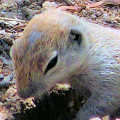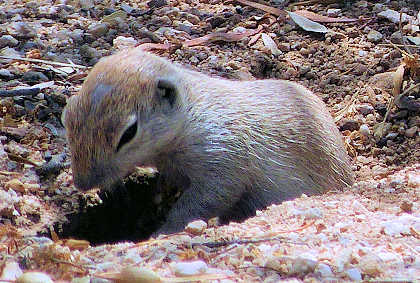Protecting Gardens from Critters
FOOD PLANTS
Culinary Herbs
Fruit, Berries, Nuts
Peppers, Chilies
Strawberries
Tomatoes
Vegetable Calendar Zone 9
ORNAMENTALS
Grasses
Ground Cover
Perennials
Shrubs
Succulents
Trees and Palms
Vines
SPECIALTY GARDENS
Butterfly Garden
Erosion Control
Fragrance Garden
Hedges, Barriers, Screens
Hummingbird Garden
Long Blooming
Winter-Blooming
GARDENING TIPS
Dealing with Critters
Digging Holes for Plants
Fruit: Selection, Cultivation
Garden Bed: Sterilizing
Landscaping
Microclimates
Parasitic Plants
Plant Placement
Selecting Plants
Soil Prep for Vegetables
USDA Hardiness Zones
Planting, Watering, Shrubs, Trees
NURSERIES / SUPPLIES
Online
Phoenix
Tucson
MEETINGS
Phoenix Meetings
Tucson Meetings

Choosing Plants
While living with our native creatures can be frustrating, many native plants have
survived in unprotected spaces for years. An Internet search on "critter resistant plants"
with your state or city name will provide lists of plants that are distasteful
to native animals.
Protecting Plants Outside of Fences
All new plantings outside of a rabbit-fenced area should be initially protected with
fencing that excludes baby rabbits. Baby rabbits can get through fencing with 2" (5cm)
diameter holes.
Wrap all new tree trunks with 1/2" (13mm) wire mesh (loosely) and remove after one or two years. Apple tree bark is very tasty. In general, rabbits are most attracted to the bark of rose family plants, especially fruit trees.
After mulching the planting hole surface, if the plant is outside a javelina-proof wall or fence, place rocks or pavers on top of the mulch to prevent a hungry javelina from digging for grubs.
Place Rosemary clippings on planting surfaces. Critters do not like the smell.
Plant distasteful plants between desirable ones to confuse the critters' noses.
Drought Makes Critters Desperate
When a drought goes on for more than four weeks, critters start to get desperate.
All plants that are watered in a drought, even if once a month, need to be protected against
javelina, rabbits, rats and mice.
Once a plant is watered in a drought, javelina or rabbits will dig it up and eat it even
though they would not touch it unwatered.
Fences, Walls, Containers and Garden Cages
Consider fencing your garden or part of your yard to keep javelina and large critters at
bay.
Heavy-duty, 4' (1.2m) high field fencing supported by 6' (1.8m) long iron T-posts provides
relatively inexpensive, secure fencing.
T-posts are most easily driven into hard ground after a long, heavy rain.
4-8' (1.2-2.4m) high walls are used to keep out rabbits and javelina and offer wind protection. They do not keep out skunks.
It is common to build raised vegetable garden beds having walls 18-24" (45-20cm) high using masonry blocks. These deter rabbits. The walls have a concrete footing one foot deep that discourages some burrowing animals. A capstone with rounded edges is placed on top to allow people to sit. The width of the bed is often two arms' length so that gardeners can sit and tend the entire bed using both sides. The raised bed, filled with soil, is open at the bottom and allows excess water from monsoon rains to drain quickly, avoiding waterlogged roots.
Plants can be placed in horse watering troughs or other tall containers that deter rabbits. The sides must be well protected from the sun to avoid overheating roots. The bottoms must have drainage holes to prevent soggy soil and fungal diseases. To keep burrowing animals out of the drainage holes, cover them with wire mesh, cover the mesh with gravel, then top with soil.
Some plants may have their roots eaten by burrowing animals. Hanging baskets have been used to avoid the problem. Another solution is to use a wire cage that is buried in the ground. The plant is placed inside the cage and the damage is limited to roots outside the cage.
Rabbits can be kept out of a garden area with 18-24" (45-20cm) high chicken wire or 1" (13mm) wire mesh fence.
Garden cages, using 1" (2.5cm) wire mesh on sides and top, can keep out birds and critters smaller than javelina, with 1/2" (13mm) wire mesh needed to keep out rats. Burrowing rats will also require 1/2" (13mm) wire mesh on the bottoms of raised garden beds. Paving brick or stone can be used for interior walkways and the outer sides of the cage to control weeds and burrowing animals.
Keeping Birds Away
Birds can be deterred by using bird netting or green tulle fabric to cover a compact
fruiting shrub or tree.
They can be ordered online in a variety of sizes.
Tulle fabric is preferred over bird netting because it does not trap lizards, snakes or
struggling birds.
Bird netting may be required, however, if a plant is large or not compact.
Fruit protection bags, usually made of a netting material, can be used to cover and hide individual large fruit or clusters of small fruit. They deter most bird pecks and insects.
If you are growing strawberries outside a cage, get strawberry shaped and sized rocks, and paint them to look like strawberries. Place them on the ground around your plants before the strawberries appear. Birds will peck at the rocks, thinking they are ripe fruit. They hate pecking hard objects and when your strawberries appear they will leave them alone, expecting them to be rock hard.
Keeping Rodents Away
Rats can be the most difficult gardening problems to deal with in a desert. There are many
species of desert rat, and although they may be called wood rats, pack rats, or roof rats,
all damage plants. They may dig around roots to get at water and grubs, eat leaves of
tasty new plantings, climb up a tree to get fruit, or cut off a branch of a small plant
just to see if it tastes good.
Desert rats like to burrow under certain plants in the landscape such as prickly pear cactus. This cactus, which rats also use as food, needs to be eliminated to avoid giving rats easy shelter. Other places for rodents to burrow are plants with low or on-ground branches, such as agave, desert spoon and succulents. Their low branches need to be removed to expose the area to birds of prey like hawks and owls.

All irrigation lines must be buried in the ground. Flexible tubing located above ground is easy to chew through. Check for, and fix, any leaks in water lines as soon as they occur. Irrigation lines and wet soil attract rodents, which are always looking for water.
Two of the best bait foods for rats are a piece of fresh tomato and peanut butter. The problem with peanut butter is that some species of small black ants love peanut butter and a colony will consume an entire bait cup of the product in one night. Putting out baited rat traps can also be problematic because mice will eat the bait without triggering the trap, accidentally protecting the rats.
Never use poison bait. The poison will kill beneficial birds and snakes that prey on rodents.
The best solution is to surround a new plant with a cage composed of 1/2" (13mm) wire mesh. Often the cage bottom needs to be buried 6-12" (15-30cm) deep in the soil to prevent a rodent from burrowing underneath. It must completely cover the plant and have room for growth. Large cages are often used to enclose an entire vegetable garden.
The ultimate solution for desert rats is a small terrier or dachshund that likes to dig into burrows and kill rats. Cats normally do not attack rats and prefer to go after mice, although rats will stay away from locations that cats frequent.

Vegetable and Herb Gardens
Seedlings can be treated as a salad bowl by mice or rats, especially in droughts.
Try a mouse trap baited with a cherry tomato or a grape first.
If nothing is caught, switch to rat traps.
When mechanical traps do not work, a cage made of 1/4" or 1/2" (6mm or 13mm) wire mesh can
be constructed to cover the seedling bed.
Such a cage has the advantage of providing filtered shade to the seedlings it surrounds.
The cage is removed when the seedling is robust enough to deter mice or is too large for
the cage.
Some vegetables and herbs are more distasteful to rodents than others. These include radishes, hot chili peppers, carrots, rosemary, and parsley.
If your low-hanging tomatoes have been nibbled, think mice, not lizards. Mice love tomatoes but cannot easily climb tomato plants. Lizards can be seen near the top of tomato plants waiting for a passing insect.
While mice do not eat peppermint, rats will, and they can tolerate its presence. A hungry rat will eat lettuce and green onions growing next to a peppermint plant.
If you grow strawberries, they are in danger from mice, rats, and birds. A cage of 1/4-1/2" (6-13mm) wire mesh over the garden bed is necessary to protect them.
Insects
If a large chunk is eaten out of some fruit, consider the possibility of grasshoppers.
Smaller holes can be fruitworms or bird pecks.
Grasshoppers can be deterred with a garlic-Habanero spray.
MAKING HABANERO CHILI-GARLIC SPRAY for Insects
Drop four Habanero peppers and four peeled garlic cloves into a blender with 2 cups
(475ml) of water.
Grind well, let set for two days, then filter out the solids.
Spray on any part of a plant that insects, especially grasshoppers, might take a bite of.
This spray must be re-applied after every rain.
Latest update: May, 2025
© 2008-2025 by GardenOracle.com

